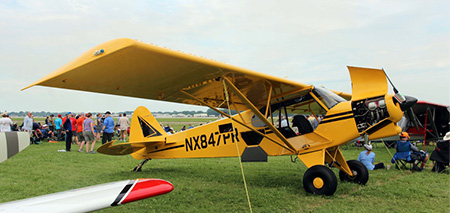This account of a loss of situational awareness at an unattended aerodrome, has as much relevance today, as it did when it happened some years ago.
I was reminded of my own close call at North Shore aerodrome, as I read the Vector article, Things that jeopardise your lookout (Spring 2023).
That article described a number of mid-air collisions, and emphasised that they all occurred when the pilots were undertaking degrees of non-standard practice.
Looking at my own near miss, I recognised two nonstandard factors. Firstly, I was flying low-level circuits, and secondly, the Piper Cub I was flying was NORDO.
On the day in question, I was practising solo circuits at North Shore aerodrome on sealed runway 21. With extensive dual training under my belt, I remember feeling confident in my flying skills and in my level of situational awareness. I’d been completing low-level circuits with a slipping turn onto final approach. The Cub I was flying was a magnificent aircraft to throw around.
Despite mostly favourable weather conditions, I had to contend with a lowering winter sun. The sun’s position obstructed my view when making a left turn from the downwind circuit position for runway 21.

A Piper Cub similar to the one flown by the author | Photo courtesy of David Gill
The glare was horrible at times and while I’d experienced significant glare before, I’d never been faced with that situation in a NORDO aircraft.
As I prepared to turn on to base leg for what would become my last circuit for the day, I performed my usual scan. But because of the glare, however, I rushed through it.
‘Confident’ there wasn’t any traffic to worry about, I executed my usual side-slipping turn onto medium final approach.1
On joining final, I began to descend. As I approached the boundary fence on runway 21, I happened to look down.
Below me, there wasn’t just one, but two, pairs of wings shadowing the ground.
My thoughts at the time were very calm. I analysed the situation and corrected it. There was no fright, no pause, just an instant response. I remember thinking, “hello”, then applied full power and climbed out to the right of the sealed runway for a go-around. I then re-circuited to land.
After realising what had actually happened, my calm demeanour amazed me, given that I’d almost landed on top of a Cessna 150, which was being flown by a young student pilot.
In contrast, the closest call I’ve had in a motor car was enough to give me the shakes afterwards. But I truly felt calm in the cockpit, despite the initial surprise. I credit that calm response to my long experience as a yachtsman. I’d encountered and navigated numerous emergency situations, some also requiring collision avoidance. This experience likely played a pivotal role in saving my life that day.
When I thought about it a bit more deeply, I realised that after my Cub came out of the sideslip onto final, it would have been approaching runway 21 at approximately 52 kts, whereas the C150 would have been travelling at approximately 60 kts.
That particular Cessna was slightly peculiar in those days, in that it used only 30 degrees of flap on approach, as opposed to the usual 40 degrees for earlier models of C150.
This made the Cessna’s approach a bit quicker than usual. Unknown to me at the time, the Cessna pilot had done a larger than normal circuit and had come in on a longer final at a low angle of approach.
As we approached the runway together, he would have been moving away underneath me, but likely not fast enough to maintain separation had I continued to descend.
I’m fairly certain it would have been a mid-air collision if I hadn’t taken avoiding action.
Later, I approached the young pilot of the Cessna 150 and apologised. He looked at me with a worried expression. It turned out he didn’t know I was in the circuit either. He also hadn’t seen me climb out ahead of him on my go-around.
The crucial lesson
That incident marked the last time I piloted an aircraft without a radio. The true lesson I took away from that day, however, was if you can’t effectively scan ahead to your intended position, don’t go there.
Avoid venturing into that airspace until you’re 100 percent sure it’s safe.
Looking back, what I should have done that day was extend my downwind leg. Doing so would have allowed me to complete an additional visual check to the left, from a position where the sun’s glare was less blinding.
Had I done that, I wouldn’t have had that glaring blind spot, and would have picked up the other aircraft in time.
Footnote
Side-slipping allows you to adjust your angle and rate of descent in a flapless configuration.
CAA comment
Today’s aerodromes are far busier than when the author of this story was conducting their low-level circuits. Today, while low-level (500 ft AGL) circuits are part of the training syllabus – particularly to cover low‑ceiling operations – conducting low-level circuits at an unattended aerodrome must take traffic and conditions into account.
Good airmanship means low-level circuits should not be conducted while other traffic is involved.
Remember to apply right-of-way rules and stay alert when choosing to conduct a low‑level circuit.
